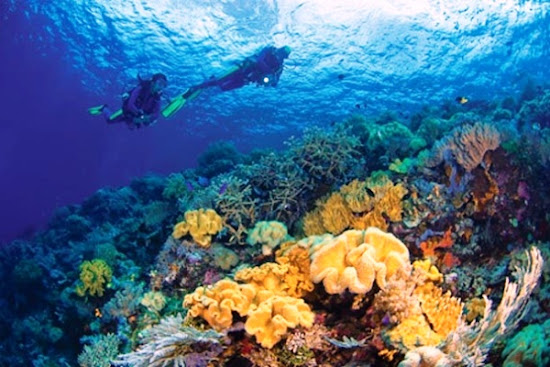| Wakatobi National Marine Park is considered one of the waters that have a wealth of marine life and coral reefs as the best in the world. In other words, Wakatobi marine tourism destination can be highly recommended for domestic and foreign tourists. Wakatobi is Southeast Sulawesi, Indonesia. |
 |
| Wakatobi, Southeast Sulawesi, Indonesia. |
Astronomically, Wakatobi located in the south of the equator, and like other regions in Indonesia, Wakatobi has two seasons, rainy and dry seasons. Wakatobi National Marine Park, inaugurated in 1996, with a total area of 1.39 million hectares, has a variety of marine biodiversity and coral which occupies one of the highest priority position of marine conservation in Indonesia.
The beauty and natural wealth in the Wakatobi National Park is already well known abroad, especially after Wallacea expedition from England in 1995 which mentions that the region of Southeast Sulawesi is very rich in coral species. There, there are 750 of the total 850 species of coral in the world. Configuring the depth varies from flat to sloping to the sea, and in some areas there is a rugged steep waters. The most deep waters reached a depth of 1044 meters.
Marine tourism is a tourist activity has long been recognized and is the mainstay of tourism in the Wakatobi National Marine Park. The wealth of marine life is because of the coral reefs along the vast waters of the underwater topography colorful as slop shape, flat, drop-off, atoll and underwater cave. More than 112 species of corals from 13 families including Acropora formosa, A. Hyacinthus, Psammocora profundasafla, Pavona cactus, Leptoseris yabei, Fungia molucensis, Lobophyllia robusta, Merulina ampliata, Platygyra versifora, Euphyllia glabrescens, Tubastraea frondes, Stylophora pistillata, Sarcophyton throchelliophorum who live in harmony with other underwater inhabitants.
 |
| Wakatobi Beach Pier. |
Wakatobi National Marine Park is also a point of some kind of sea birds such as goose-brown stone (Sula leucogaster plotus), Malay plover (Charadrius peronii) and King Prawn Eurasia (Alcedo atthis) nested. Several species of turtles also make this park as their home, for example, hawksbill (Eretmochelys imbricata), loggerhead turtle (Caretta caretta), and fission turtle (Lepidochelys olivacea).
Wakatobi waters have loyal guests who make Wakatobi waters as a playground, the guest is the sperm whale (Physeter macrocephalus). Usually, the group of sperm whales in Wakatobi in November, while the other hemisphere freezes. In the month, the temperature in the Wakatobi relatively warmer waters and abundant food can be filling stomachs of whales herd. Not only that, Wakatobi is also a place to play manta rays (Manta ray) were classified as giant body size. Manta is one of the distinctive and unique fish, and is only found in tropical waters.
The presence of 25 pieces of coral reef with a depth that makes the waters ideal in Wakatobi National Marine Park as an ideal place for many species of marine life to live there, making the inhabitants of the sea here has aesthetic value and high conservation.
Specifically, the Wakatobi National Marine Park surrounded from the beach by coral islands along the 600 miles along the beach attractions with huge potential to run, spread throughout the Wakatobi region. It was not without reason that the beach area in Wakatobi is perfect for marine tourism activities such as diving, snorkeling, swimming and fishing.
Access to the Wakatobi islands can be reached by air. For air transport, usually preceded by the route of flight from Makassar to Kendari, the capital of Southeast Sulawesi province. Furthermore, the flight continued to Wangi-Wangi, Wakatobi capital. According to information, available at this time also had a direct flight from Makassar to Wangi-Wangi.
No comments:
Post a Comment